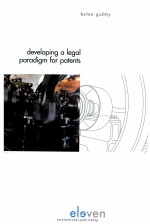
- 作 者:Gubby
- 出 版 社:Eleven International Publishing;International Specialized Book Services [Distributor]
- 出版年份:2012
- ISBN:9789490947385
- 标注页数:367 页
- PDF页数:377 页
请阅读订购服务说明与试读!
订购服务说明
1、本站所有的书默认都是PDF格式,该格式图书只能阅读和打印,不能再次编辑。
2、除分上下册或者多册的情况下,一般PDF页数一定要大于标注页数才建议下单购买。【本资源377 ≥367页】
图书下载及付费说明
1、所有的电子图书为PDF格式,支持电脑、手机、平板等各类电子设备阅读;可以任意拷贝文件到不同的阅读设备里进行阅读。
2、电子图书在提交订单后一般半小时内处理完成,最晚48小时内处理完成。(非工作日购买会延迟)
3、所有的电子图书都是原书直接扫描方式制作而成。
Introductiontent Courts and Court Reporting 13
1 The PaCourt Structure 14
1.1 The ivy Council 14
1.1.1 Pre Common Law Courts 17
1.1.2 The Equity Courts 19
1.1.3 Thnt Actions in the Common Law Courts 20
1.2 Patent Judgments and Verdicts in the Common Law Courts 22
1.3 Patensuit 23
1.3.1 Notion for a New Trial and a Writ of Error 24
1.3.2 Mories in the Common Law Courts 25
1.3.3 Ju1.4 Patent Actions and Judgments in the Courts of Equity 30
1.5 Parliament 33
1.6 Law Reports 36
1.7 Summary 44
2 Division Within the Judiciary: Were Some Judges 'Hostile' to Paten- tees? 45
2.1 The Role of the Judge: Modern Insights 48
2.1.1 The Formalism Approach 48
2.1.2 The Creative Approach 50
2.1.3 The Bounded Creativity Approach 53
2.2 The Role of the Judge: Eighteenth Century Legal Treatises 55
2.3 The Role of the Judge: The Eighteenth-Early Nineteenth Century Bench 64
2.3.1 Internal Divisions: Divergent Backgrounds within the Community 67
2.3.2 Internal Divisions: The Style of Interpretation 72
2.3.3 Perrin v. Blake 1769-1772: The Internal Divisions Unmasked 77
2.4 Analysing the Attitude of Judges in Patent Disputes 82
2.5 Summary 84
3 Patent Law: The Interpretation of the Statute of Monopolies 1624 from the 1750s to the 1830s 87
3.1 The Importance of the Statute of Monopolies 88
3.2 The Criteria for Statutory Interpretation 92
3.3 The Judicial Interpretation of Section Ⅵ of the Statute of Monopolies 1624 100
3.3.1 The 'True and First Inventor' 101
3.3.1.1 The 'True and First Inventor' in Legal Treatises 103
3.3.1.2 The 'True and First Inventor' in Case Law 105
3.3.2 'New manufactures' 109
3.3.2.1 'Manufacture' Defined in Legal Treatises 110
3.3.2.2 'Manufacture' Defined in Cases 114
3.3.2.3 'New' 130
3.3.3 'Contrary to the Law, nor Mischievous to the State, by Raising Prices of Commodities at Home, or Hurt of Trade, or Generally Inconven-ient' 140
3.3.3.1 Mechanisation 143
3.3.3.2 Utility 148
3.4 Summary 151
4 Patent Law: The Interpretation of the Patent Specification from the 1750s to the 1830s 155
4.1 The Introduction of the Patent Specification 155
4.1.1 Why Did the Doctrine of Patent Specification Arise in the Early Eight-eenth Century? 157
4.1.2 Who Was behind the Instigation of the Specification? 158
4.2 The Interpretation of the Patent Specification by the Judges 163
4.2.1 The Function of the Specification 163
4.2.2 The Instruction of"the Public" 173
4.2.3 The Requirement of Equal Benefit 175
4.2.4 The Wording of the Specification 176
4.2.4.1 The Patent Specification Read within the Context of a Monopoly Grant 179
4.2.4.2 The Patent Specification Read within the Context of Protecting the Public against Monopolies for Fraudulent Patents 180
4.2.4.3 The Patent Specification Read within the Context of the Contractual Approach 184
4.2.4.4 The Diversity of Approach 189
4.3 Understanding the Patent Specification 195
4.3.1 Directing the Jury 197
4.3.2 The Specification as a Text 199
4.3.3 Examining the Technology 200
5 The Patent Monopoly: Factors Affecting the Attitude of Judges to the Monopoly Grant for Patents for Invention 207
5.1 The Patent as a Monopoly: The Negative Association 207
5.1.1 The Monopoly as against the Common Law 209
5.1.2 The Monopoly from the Economic Perspective 219
5.1.3 The Monopoly as Contrary to Morality and Religion 225
5.1.4 The Monopoly as Contrary to Natural Law 230
5.2 The Status of the Inventor Patentee 235
5.2.1 The Comparison with Authors 235
5.2.2 The Public Good and Religious Doctrine 238
5.2.3 Privilege or Right? 243
5.3 Vested Interests 244
5.4 Summary 249
6 The Patent as a Form of Personal Property 251
6.1 The Patent Specification as a Contractual Relationship 252
6.2 The Organisation of the Law of Property at Common Law 258
6.2.1 The Categories of Real Property and Personal Property at Common Law 259
6.2.2 The Legal Consequences of the Distinction 260
6.3 The Object of Property at Common Law 261
6.3.1 Blackstone's Definition of the Object of Property 262
6.3.2 Judicial Debates on the Object of Property 264
6.4 The Patent as a Form of Personal Property 272
6.4.1 The Patent and Copyright: Species of Common Law Property? 273
6.4.2 The Relationship between the Subject Matter of a Patent and the Object of Property 282
6.4.3 The Social Rise in Significance of Personal Property 287
6.5 Summary 291
7 From the Industrial Revolution to the Digital Revolution: The Soft-ware Challenge 295
7.1 Developing a Legal Concept of Software 296
7.2 The Present Patent Framework 297
7.2.1 Software Patent Litigation 298
7.2.2 The Role of the Judge 299
7.3 Determining the Patentability of Process Inventions 301
7.3.1 Interpreting the Term 'Manufacture' 301
7.3.2 The Interpretation of a Computer Program 'as such' 303
7.3.3 Comparing the Interpretation of'Manufacture' and a Computer Program 'as such' 312
7.4 The Attitude to Monopolies 314
7.5 Legal Uncertainty 317
7.6 Summary 320
8 Conclusion 321
8.1 Factors Affecting Judicial Decision-Making in Patent Cases 321
8.1.1 The Interpretational Style of Judges 322
8.1.2 The Attitude of Judges to the Monopoly Granted by Patent 326
8.1.3 The Attitude of Judges to the Patent as a Form of Property 328
8.2 The Shift in Judicial Interpretation in the 1830s 330
8.2.1 The Shift in Interpretation of the Statute of Monopolies 1624 330
8.2.2 The Shift in the Interpretation of the Patent Specification 333
8.2.3 The Causes of the Shift in the 1830s 334
8.3 Concluding Remarks 336
Appendix 1 The Statute of Monopolies 1624 337
Appendix 2 The Chief Justices, Chief Barons and Lord Chancellors 1750s-1830s 341
Bibliography 343
Index 357
Curriculum Vitae 367
